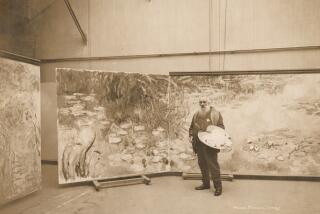Oskar Kokoschka: <i> A Life by Frank Whitford (Atheneum: $17.95; 288 pp., illustrated) </i>
- Share via
Not without good reason has Oskar Kokoschka, the most significant Austrian painter of our time, been compared with Pablo Picasso. Both were born in the 1880s. Both lived long enough to reflect the cultural and social history of our century up to the recent past. And both absorbed the attention of the art world by the picturesque spectacle of their personal lives as much as by the power of their work.
But it is the difference between the two artists rather than the similarity that tells Kokoschka’s story most graphically. Picasso lived and worked in close interchange with the generations of artists he came to know, and his work translated a dazzling variety of modernist styles into his own personal idiom. Recognized and celebrated, he spent a sheltered existence in his mansions and palaces; and by now, 13 years after his death, whole museums in France and Spain are dedicated to his work.
Kokoschka, by contrast, struggled for recognition until the very end. He refused to acknowledge any other artist’s influence. Although he was willing to call himself an Expressionist, he insisted on having invented and led the movement singlehandedly. In fact, Expressionism is the one modernist style that served him from his somewhat mannered beginnings to a mature synthesis of form and subject, in which reality itself is felt to confront the viewer with compelling immediacy.
Biographies of Kokoschka have not been lacking. The first, written by the German art critic Paul Westheim, appeared in 1918 when the artist was 34 years old. Another excellent monograph, introduced by the English critic and poet Herbert Read, was published by Edith Hoffmann in 1947. There have been others. These early publications, however, were hampered by the limited access to sources and by Kokoschka’s own inclination to dramatize his personal and professional adventures by a good deal of fiction. His autobiography of 1971 profits from the liveliness of his imagination.
“The facts are rather different”--this sentence keeps recurring in Frank Whitford’s book, and it also indicates the principal merit of this new biography. The author, who teaches art history at Cambridge University, has been able to use correspondence in the possession of the artist’s widow. A thorough perusal of all documents and publications thus far available has resulted in the most careful documentation yet put together on the subject. Innumerable quotations let us hear the voices of Kokoschka himself, his family, his mistresses, his friends and students. Even so, Whitford’s book is curiously uninspired.
He asserts that we know less about Kokoschka the man than we do about his life: “ . . . his personality remains elusive. In all the accounts of the artist’s life it is not so much Kokoschka himself as the people around him who emerge with the greatest clarity: (Adolf) Loos, (Karl) Kraus, (Herwarth) Walden and Alma Mahler all appear as figures in the round while Kokoschka seems shadowy, contradictory.” Nevertheless, the author seems to me much more successful in analyzing the artist’s person psychologically than in making the spirit of the work come across to the reader. One might say that what his verbal portrait lacks most is precisely what the painted portraits of the artist are praised for. Again and again it has been observed that Kokoschka’s portraits, among them many of public figures, lacked resemblance in the usual photographic sense but that he had an almost clairvoyant talent for unveiling the deep-seated forces of the sitter’s personality.
The talent of his biographer is more nearly the opposite. Whitford’s descriptions of events and characters are detailed and accurate, and given the captivating wealth of the panorama, especially that of the Europe preceding the Nazi period, his book makes for fascinating reading. But the descriptions of the artist’s work, whose vital originality is what justifies our interest in the first place, are limited too often to dry technicalities. One cannot compare Kokoschka’s paintings with the spiritual of El Greco, as Read has done, or with the passionate response to suffering in Matthias Gruenewald, as has been suggested by others, without evoking the human substance of this great artist in the startlingly vibrant brush strokes and colors of his unforgettable images.
More to Read
The biggest entertainment stories
Get our big stories about Hollywood, film, television, music, arts, culture and more right in your inbox as soon as they publish.
You may occasionally receive promotional content from the Los Angeles Times.










